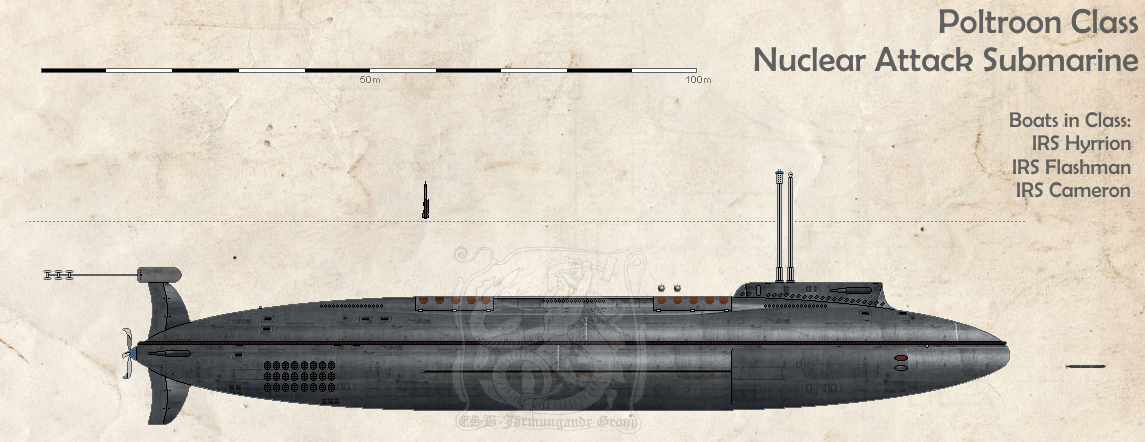Poltroon Class Submarine
| |

| |
| Type: | Nuclear Attack Submarine |
| Place of origin: | Shireroth |
|
| |
| In service: | 1636 AN - Present |
| Used by: | Imperial Shirerithian Navy |
| Planned | 105 |
| Completed: | 105 |
| Commissioned: | 105 |
| Retired: | 2 |
|
| |
| Designed: | 1635 AN |
| Manufacturer: | ESB-Jörmungandr Group Boat Yards of Amity |
|
| |
| Displacement: | 12,139 tons (Submerged) |
| Length: | 132m |
| Beam: | 12m |
| Draught: | 11m |
| Propulsion: | PWR2 reactor (with full submarine life core), MTU 600 kilowatt diesel generators; |
| Range: | Unlimited, except by food supplies and maintenance requirements |
| Test Depth: | Over 300 m |
| Speed: | 54 km/h Submerged |
| Complement: | 98 officers and enlisted, capacity of 109 |
| Armament: | 10x Banshee Cruise Missiles (rocket/ramjet, explosive penetrator warhead, Dimethyl Mercury payload, range 2,000km) in 10 vertical launch silos 50x Drifting contact mines in 10 vertical ejection chutes |
| Sensors and Processing Systems: | |
| Cost: | 11,709,401.71 Teldrin Thalers |
The Poltroon Class of Nuclear Submarines was authorised by the Chief Secretary of the Imperial Forces in 1635. The class represents an evolution of the hull design of the Asleep-class submarine employed by the Musican Navy. Any similarities with submersible vehicles of Minarborian origin are entirely coincidental.
The initial project, commenced in 1635 and took twelve years to complete. The first phase involved the construction of dockyard facilities in which to build and maintain the submarine type and took take six years to complete. The remaining six years saw the construction phase of the three initial submarines.
One dockyard was reserved for fleet maintenance whilst the other two were assigned to the purpose of constructing further boats in the same class. With improvements derived from economies of scale and efficiencies derived from improving methodologies during each build, the dockyards, located on the island of Amity, aim at a construction rate of two new boats every four years.
This rate of production did not prove satisfactory for the Imperial Navy and, as tensions with Jingdao worsened, a wartime tempo of submarine building was implemented, with many other projects being halted or sidelined to give over ship-building facilities to the construction of further Poltroons. The number of boatyards proliferated throughout the islands of Yardistan, Amity, Miriroth and So-Sara. By 1653 the frenetic pace of construction eased off as the ambitious targets for construction and commissioning into Imperial service were substantially met. The rate of acceptance into operational service by the Imperial Navy lagged far behind, as the shortcuts taken during the accelerated building programme had manifested themselves in a myriad of defects that were both time exhausting and expensive to rectify.
The programme had benefited from the Jingdaoese war scare of 1647, which had marked the type's first extended operational deployment away from home waters.